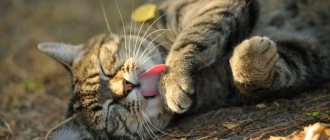In the cold, a winter cat does not freeze much. Thanks to its dense, thick fur, the animal can easily tolerate low temperatures, and even when it is very cold in winter, the seals ask their owner to let them go for a walk. However, you should not leave your pet outside at temperatures below 15 degrees, because not all cats survive extreme weather conditions and can suffer from hypothermia and related consequences.
What sub-zero temperatures can cats tolerate?
Most cats tolerate low temperatures well. Thanks to its thick and dense coat, the animal is able to survive severe frosts, reaching down to -15-20 °C. However, you should not think that your pet will easily cope with extremely harsh weather conditions. The animal will not survive if the thermometer drops below -20-25 degrees outside in winter.
Unfortunately, not every cat has a warm home and caring owners. A stray cat has a much greater chance of freezing, especially at night. In winter, street animals often live in basements, hallways, and abandoned buildings. This is the only way to survive and not freeze to death.
How do cats survive the winter cold?
A pampered domestic cat freezes at the slightest drop in temperature, but surviving a harsh winter is not a problem for such pets, because they have loving owners and a warm home.
© shutterstock
It is much more difficult in winter for homeless animals who are forced to take care of themselves. Dogs survive the winter by huddling in packs or digging deep holes in the snow. Cats do not know how to dig holes and, being solitary by nature, avoid the company of other representatives of their kind. Therefore, in order to survive the winter, cats had to invent their own ways of survival.
Preparing cats for winter:
- Thick and long hair provides cats with excellent protection from the cold, so in winter, animals stop shedding;
- Outdoor cats actively hunt mice and other rodents in the fall in order to stock up on fat, which helps them stay warm in severe frosts;
- Another interesting fact: in winter, cats hardly wash themselves, since with wet fur the animals are more susceptible to the cold;
- To survive severe frosts, stray cats look for suitable shelter in advance. Usually, porches, warm basements or abandoned houses become shelters for animals.
What rocks freeze in winter?
Cats with fluffy coats, for example, Maine Coons, Siberians, Neva Masquerade, Norwegian, feel comfortable in the cold. The same cannot be said about short-haired and hairless breeds, such as:
- Abyssinians;
- Persians;
- Burmese;
- Devon and Cornish Rex;
- sphinxes, bambino.
Purebred couch potatoes are very difficult to tolerate temperature changes.
What temperatures cats can withstand depends not only on external factors and the presence of warm fur and breed. For example, a kitten will freeze very quickly because its thermoregulation is not fully developed. For the same reasons, older pets also freeze. A cat that lives at home all the time and is not used to street life can immediately get frostbite. Short-haired breeds are absolutely not suitable for living outdoors. If the temperature is not so comfortable for him, the cat will immediately get sick and die. The maximum that a purebred pet can afford is to sit on the balcony, wrapped in a warm blanket.
If a hairless or short-haired pet is lost in winter, it will not be able to withstand low temperatures. Therefore, when you happen to see an unfortunate animal on the street, you should not throw it to certain death. We need to help the cat survive.
Does a cat's fur keep her warm?
Sphynx cats definitely get cold, but what about cats with fur?
Pets with a dense, well-developed undercoat are most fortunate in terms of insulation. It is designed to retain natural heat, maintaining the animal's normal body temperature for a long time. But, as in the case of human clothing, such protection does not last forever: if a person, even warmly dressed, after spending some time in the cold, begins to feel cold, the same happens with cats. If we talk about the temperature at which animals begin to freeze, then everything depends not only on the thermometer readings, but also on other factors:
- whether the pet is in motion or sitting still;
- what is the air humidity;
- is there any wind;
- whether the sun is shining or cloudy, etc.
In “dry” frost, cats do not feel the cold longer, and if the pet does not move, it begins to freeze quickly. With increased humidity, the pet freezes even faster. Practically, in this aspect, everything happens the same as in humans, but with one clarification - cats are superior to people in endurance.
Representatives of hairless breeds and breeds without undercoat are less resistant to low temperatures than cats with “shaggy” coats. Streams of cold air quickly penetrate the skin, but the heat is not retained. When such pets freeze, their ears and limbs become cold, even if the walk does not last long and the thermometer shows a temperature of at least -15°C.
But Maine Coons, Siberians and other cats with good coat protection, especially if they are not too pampered, can safely walk even at -25 - -30°C.
At what temperature can a cat walk in winter?
Thanks to the special structure of the coat, the cat walks freely in cold weather without experiencing discomfort. The heat generated by the body remains under the fur coat; thanks to this thermoregulation, these animals survive and are not afraid of low temperatures. However, wet fur loses its ability to retain heat, so it is extremely undesirable for snow to remain on the fur coat, which will then melt and get under the fur.
But a cat has unprotected areas of its body - its paw pads. There are much fewer receptors on them, and if it is minus 15-20 °C outside, the cat runs the risk of frostbite. Therefore, when the thermometer drops below 20 degrees, a pet tries to hide in the house, and stray cats and kittens take refuge in basements.
Do cats need outdoor walks?
In fact, they have a hard time and even the most wind- and frost-hardened cats are not always able to withstand the winter period, especially if it has been frosty for a long time.
In such a situation, it is much easier for dogs to survive the winter - they know how to tear up the ground or snow, constructing holes and rookeries. They are also pack animals and can keep each other warm by huddling closely together. Cats are loners, so not all of them survive the winter.
If in summer you can see a lot of murkas on the street, then in winter they are practically invisible. If you're lucky, they make their home in basements or attics.
Here the division no longer depends on the personal qualities and preferences of the animal, but on the living conditions. As a rule, cats living in the private sector walk all year round. Typically, such pets are equipped with an undercoat and can feel good even in cold weather. Only the owners should provide unimpeded access to the home so that Vaska or Masha, who has been having a good time, does not freeze while trying unsuccessfully to enter the house.
READ Training an English Cocker Spaniel
But cats that are not allowed out or are not eager to be “freed” themselves can freeze in the cold. There are frequent cases of pets freezing into ice, frostbite of limbs, ears and tails and other tragic situations. Most often this happens when an unadapted pet ends up on the street - of his own free will or not, and cannot return home.
Cats do well without street walks, and if they have such a desire, you can always use a harness and take out the four-legged reveler. Usually, two or three walks in the cold are enough for homebody pets to cool down their ardor, and they calmly wait for the warmth, looking out of the window.
As you can see, cats are not “walruses” at all, and they will not “harden” unless they find themselves in harsh conditions. Of course, these animals, like all others, are more resilient and strong than humans, but their heat-loving nature is very pronounced. Therefore, if a cat freezes while walking, then most likely she does not need such stressful situations. It’s worth postponing walks until spring!
Of course it's freezing! It is absurd to think that since a cat is originally a wild animal, it can easily and easily adapt to frost and winter cold. Even the super woolly indoor cat needs the warmth of the hearth in winter.
Observing our pets, we come to the conclusion that even at room temperature, cats find a place where it is warmer - and it is there that they curl up and rest. What can we say about frosts?
The answer to this question cannot be universal for all Muroks and Murzikovs. Some experts do not recommend walking at -20°C. But this is a very relative parameter. Because there are a lot of factors that affect the “winter hardiness” of each individual animal.
- Breed. It’s easier for mongrels, but for sphinxes, for example, it will be cold even at 10°C.
- Wool, presence or absence of undercoat.
- Habit. There are representatives who walk around their property in any weather, especially in the villages, few people bother with cats and cats. But our village man managed to get a slight frostbite in his ear - and it’s simply impossible to keep him in the house. And there weren’t even any significant frosts...
- Age. Kittens and old animals cannot keep their body temperature constant.
- General health. Hidden diseases, pregnancy in cats weakens the animal and its resistance to low temperatures decreases.
Winter means not only the Christmas and New Year holidays, it also means cold winds and frosts. If for humans the street frost is a joy, then cats, especially those that live on the street, do not like it too much.
Low temperatures with prolonged exposure cause lasting changes even in the physiological state of cats and their behavioral characteristics. Even pets feel the winter.
When a pet asks to go outside in winter, many owners wonder at what temperature do cats freeze and is it worth letting them out for a walk when the thermometer has dropped below zero?
It all depends on the length of the coat and the breed of the animal. Maine Coons, Norwegian Forest cats and Siberian cats have luxurious coats and a thick undercoat that perfectly protects them from the cold. Representatives of these breeds feel great outdoors even at 15-20 degrees below zero.
Hairless cats - bambino, sphinxes, Ukrainian lefties freeze in winter, even if they are in a warm house, so it is strictly forbidden to walk them in winter.
Particular attention and care should be given in winter to small kittens, pregnant cats and elderly pets, as they tolerate cold extremely poorly and can even die from hypothermia.
To make winter walks safe for your cat, it is recommended to walk your pet under supervision or on a leash. This way, the owner can be sure that the animal will not get lost or die if it finds itself outside in severe frost.
Animals, in particular cats, are not as sensitive to temperature changes as people, thanks to their fluffy and thick fur coat. Many pets that their owners let out for walks ask to go outside in any weather, and a cold frosty winter is no exception. But, if in the warm season the owners do not worry about the health of their furry pets, then in the bitter cold they are a little afraid to let them outside.
Are there any grounds for such fears and what sub-zero temperatures can cats withstand without freezing or frostbiting their paws or ears?
What to do if your cat is cold and gets hypothermia?
External signs will help you understand that it’s cold for a cat to be outside - the animal is curled up in a ball, the muscles are tense, the fur fits tightly to the body. Once in a warm room, a frozen pet tries to position itself closer to a heat source - a radiator, stove, fireplace. If the cat is very cold, you need to wrap it in a woolen blanket and place the basket near the radiator. It is prohibited to bathe the animal. Some people think that warm water will warm them up faster, but this is not the case. After bathing, the fur will dry for a long time, and the pet risks freezing even more. And instead of benefiting the animal, it will cause harm. Sometimes a cat cannot withstand such stress and dies.
To save the animal, it is necessary to melt the ice that has frozen the limbs.
If a cat finds itself frozen to the ground, it is necessary to help it free itself, because the animal will not tolerate the cold and will die. It is necessary to make sure that the ice that binds the body melts, but without harming the animal. You can melt an ice trap using warm, but never hot water. While pouring the ice, you need to help the cat free herself at the same time. So that she does not worry and worry, you should talk and stroke the poor thing. If an animal has frostbite in any part of its body, it is necessary to urgently take it to a veterinary clinic, where a doctor will provide first aid.
Behavior of cats in winter
The first thing we notice with the onset of winter is a decrease in daylight hours. Animal activity is noticeably reduced. They are no longer as mobile as before, they eat and sleep more. Calmness and laziness overcome them. Instead of games, they choose a secluded corner that is warmer. The most attractive things for them are warm blankets, shelves with linen, radiators and heaters, even a computer keyboard. All in order to waste as little heat as possible, curl up in a ball, wrap yourself in a shaggy tail.
Even by accumulating subcutaneous fat, cats fight the upcoming cold weather. Eat as much as possible, reduce movement to a minimum. The animal will defend itself instinctively. And here her interest diverges from the interest of the owner, who is convinced that the pet will not need a thick fat layer as protection from frost.
Cats are naturally designed to actively shed as a means of acquiring thick hair. The heating season makes adjustments, and molting can continue until the next spring molting. That is why it is impossible to do without regular hair care, constant combing, and various methods for removing hair lumps from the stomach.
With cold, drafts and dampness, immune problems worsen. Colds and cystitis from eternal sitting on a cold windowsill and floor overtake pets. And if a pet lingers on the balcony in the cold or is accidentally forgotten there, then the consequences can be more serious, including hypothermia or frostbite.
So, it is better to be vigilant and not allow the cat to lie down in cold places blown by winds and drafts. If the balcony is not insulated, then you should not let your pet there until spring.
Most cat owners notice that with the onset of the first cold weather, their pets behave completely differently than in the warm season. Even the most playful and active animals turn into lazy couch potatoes who spend most of their time on the sofa or near a warm radiator.
It should also be noted that all felines have an increased appetite in winter, as a result of which the pets noticeably gain weight, gaining a few extra pounds. Cats do this on a subconscious level, because their genetic memory tells them that a layer of subcutaneous fat helps them survive in winter frosts.
Some owners are worried about this and begin to limit the cat's food, fearing that the pet's excessive appetite can lead to obesity. But such fears are completely in vain, because with the onset of spring, the animal’s need for an additional portion of food will disappear, and the pet’s weight will return to normal.
Other useful tips
A pet that eats high-quality, balanced food will survive sub-zero temperatures much easier. When cold weather sets in, energy costs for heating increase. Therefore, it is recommended to pay attention to the diet, especially for kittens and older cats. In winter, it is necessary to increase the calorie content of the menu, add complete proteins and fats. These substances are found in sufficient quantities in meat and dairy products.
Homeless animals rarely eat healthy food, so it is natural that not all will survive in the cold and severe frosts. Therefore, if abandoned cats live in the yard or nearby, you should try to help them cope with bad weather. You can feed the strays with leftover food or give them inexpensive dry food. Particularly compassionate cat lovers make them a primitive shelter where the animal can hide from snow, wind and severe frost. But if the cat is cold and all the signs of hypothermia are visible, you should not leave it to suffer outside, because the body will not stand it. A rescued animal can become a new member of the family and find caring and loving owners.
Are there freezing cats?
The owners of such pets confidently answer – yes! Of course, pampered animals who only look outside from the window and then with longing, dreaming of the summer sun, freeze more often. In addition, some breeds are naturally thermophilic, especially if their origin is associated with warm regions. Such cats will huddle close to heating devices and ask for a blanket, even when there is no question of cold. Owners of such pets note that in winter their pets sleep more and move much less.
Another factor influencing the “freezing” of cats is their age. Kittens tolerate low temperatures less well due to imperfect thermoregulation mechanisms. A similar phenomenon is observed in elderly animals - their body, alas, no longer works “like a clock.”
In addition, unhealthy cats begin to freeze faster - those suffering from a disease, recovering from an illness or surgery, having a weak immune system or being very thin and lacking body fat.
How cats prepare for cold weather
Cats are not as sensitive to temperature changes as humans, thanks to their fluffy and thick fur coat.
It’s no secret that cats gain several kilograms of excess weight during the winter. In this case, owners do not need to sound the alarm and put their pet on a strict diet.
In this way, the animal prepares itself for winter, and does this on a subconscious level, thanks to genetic memory, when cats still walked on their own and were forced to take care of themselves.
All cats gain several kilograms of excess weight during the winter.
The fur of these creatures also becomes a little thicker and longer in winter and, remarkably, cats practically do not shed in winter.
Another interesting fact is that cats rarely bathe in winter, and this is due to the fact that wet fur is unable to protect them from the cold.
At what temperature can a cat walk outside?
Cats are one of the hardiest animals, and these creatures live on almost all continents, so most of them are perfectly adapted to cold climates.
Most cats tolerate cold climates well.
Thick wool and dense undercoat perfectly protect animals from cold and frost and thanks to them the cat almost does not freeze.
Extremely negative temperatures
But don't think that a cat can survive in extreme subzero temperatures. If she stays in the cold for a long time at minus twenty degrees, then this can end disastrously for her: the animal will freeze its paw pads and ears, which are almost devoid of fur.
A cat cannot survive in extremely low temperatures!
Unfortunately, not all cats are lucky enough to have a home and loving owners. Homeless animals are forced to survive in the winter, taking refuge in hallways, basements or abandoned houses.
What to do if your cat is cold
If your cat is cold, you need to wrap it in a warm towel.
As a rule, a cold cat will instinctively look for the warmest place in the house, for example, near a radiator or electric fireplace. Many animals can crawl under a warm blanket or blanket.
What you should absolutely not do in this case is bathe your pet. A hot bath will not only not help, but will also cause your pet to freeze even more after it and may even catch a severe cold.
Cat walking by itself
A cat that regularly walks outside for a long time is quite hardened and has enough skills not to freeze. If a cat has the opportunity to freely walk outside in winter, when it freezes, it will definitely hide in a shelter or ask to go home. The thick undercoat will prevent the cat from freezing even in ten-degree frosts. But, of course, this only applies to healthy animals with sufficient body weight. But it is not recommended to suddenly take kittens and non-hardened cats out for their first walk in the winter cold - the animal may catch a cold. Therefore, if you got a pet in the warm season of the year, and you decided that the cat will be walked, you should not waste time - give the cat the opportunity to get used to the natural decrease in ambient temperature, regularly let it out for a walk, in this case the winter cold will not will come as a shock to her. If a cat appears in your apartment in winter, do not risk its health - be patient with walks until the spring sun.
Recently, in large cities, the problem of protecting cats’ paws from reagents, which are generously sprinkled on sidewalks and roads in winter, has become urgent.
Reagents, no matter whether they are acids or ordinary table salt, corrode the delicate skin of a cat’s paw and cause burns. To prevent such injuries, it is recommended to treat paws with products that create a protective layer on the skin before walking.
These special waxes, creams, gels, and sprays will protect paws not only from the negative effects of deicing agents, but also from the effects of fuel oil and gasoline, and protect them from frostbite and microtrauma. The product is applied to the skin of the pads and fingers before each walk. When the cat returns home, the paws should be washed with warm water and dried. You can buy such products in pet stores and veterinary pharmacies.











